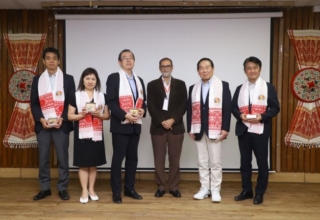
Dr Nitya Prakash, Co-Founder, VP & Global Head of Techademy Campus (the Higher Education – B2A vertical of IIHT), who is a former Director spearheading the Institute of Distance & Online Learning (IDOL) of the Chandigarh University, author, TEDx speaker and has had an association with Atal Innovation Mission (AIM), in a wide-ranging conversation speaks with Autar Nehru on the change and challenges before HEIs in India at this juncture. Techademy Campus is already catering to over a lakh students of a leading HEI in India.
Post-pandemic, phygital learning/teaching has unwittingly become a norm in education delivery and all future learning will be greatly facilitated, aided and marked by the digital technologies and related technical infrastructure. Parallelly, the policy and regulatory environment in India over the past couple of years, has also seen a sea change that has given a fillip to adaptation of blended mode in higher education.
Much unnoticeably, admission process through CUET, has been a game changer and one of the greatest achievements of ‘Tech India’ in last three decades. Add to it, Academic Bank of Credit (ABC), multiple entry and exit options announced in the NEP 2020, migrations, assessments, ERP, etc., the higher education milieu in India today is all but digital.
Prior to Covid, India’s lead on integration of technology in education delivery and a vast vibrant open and distance learning system coupled with SWAYAM MOOCs, NPTEL and international online platforms like Edx and Coursera, had already laid the strong foundations of digital online education. And, the switch over to online mode necessitated by Covid, just catalyzed its dignity and acceptance. In hindsight, it also opened the opportunity for diligent edtech businesses to engage HEI managements in reimagining the entire administration and operation of running a HEI.
On regulatory front, the UGC is fuelling this transformation. In September 2020, the commission notified University Grants Commission (Open and Distance Learning Programmes and Online Programmes) Regulations, 2020, which provided for equivalence of ODL degrees with traditional physical mode degrees. Through an amendment, the regulator also allowed NAAC 3.6 above score and top 100 NIRF rankers to start online programmes. And, through the University Grants Commission (Credit Framework for Online Learning Courses through SWAYAM) Regulations, 2021, the HEIs have been empowered to provide to 40 per cent of the total course being offered in a particular programme in a semester through the online course offered through SWAYAM platform.
In all this transformation, technology companies in learning and solutions space are also adding new verticals and features to make choices better and cost effective for HEIs. One such company that has taken a lead is IIHT (founded by Keshav Raju in 1993) that added Techademy in 2014—since grown into a leading full-stack developer skilling platform and as Techademy Campus as a provider of a reliable and savvy LMS for HEIs.
ABC and multiple entry and exit options, migration, admissions, entrances, assessments are areas which will become huge areas of operation for HEIs in coming years. What are some of the implementational and policy challenges in this?
In my view there are five areas that are critical for this transformation and I’ll enlist them as:
- Data standardization: Ensuring compatibility and uniformity of data across various systems and institutions is crucial for effective implementation. Developing standardized data formats and protocols can be a challenge, especially when dealing with a diverse range of institutions and existing systems.
- Interoperability: Integrating different platforms and systems used by HEIs can be complex. Creating interoperability standards and establishing seamless data exchange mechanisms is essential to enable smooth operation and collaboration between various stakeholders.
- Policy alignment: Aligning existing policies and regulations with the new requirements introduced by the National Education Policy 2020 can be a significant challenge. It may involve revisiting and amending policies related to credit transfer, course equivalency, and recognition of prior learning.
- Training and capacity building: Training faculty, administrators, and other stakeholders on the new systems and processes is crucial for successful.
- Infrastructure readiness: HEIs must ensure they have the necessary technological infrastructure and resources to support the implementation of these new systems.
Universities and other HEIs are invested in technology for ERPs and other processes. What happens to this infrastructure, providers and investment if they switch over to say your kind of platform?
HEIs invested in existing ERPs and infrastructure may need to assess the compatibility and feasibility of transitioning to a new platform. They will need to consider factors such as data migration, integration with existing systems, and the overall benefits of making the switch.
Two, HEIs should evaluate the terms and contracts with their current infrastructure providers. They may need to negotiate or seek alternative arrangements to ensure a smooth transition without significant financial loss or disruption.
What are going to be some of the challenges that HEIs face in integration of emerging technologies and what kind of emerging technologies are further likely to disrupt the education delivery?
Challenges faced by HEIs in integrating technology are often rooted in resistance to change. Resistance from faculty and staff when introducing new technologies is a real challenge. Then, Infrastructure limitations is the second on the list.
Inadequate infrastructure, including limited internet connectivity and outdated hardware, can hinder the effective integration of technology. HEIs need to address these infrastructure challenges to ensure seamless implementation.
Then of course, cost considerations is another major factor. Implementing and maintaining technology infrastructure can be expensive. HEIs need to carefully evaluate the costs involved and develop sustainable financial models to support the integration of technology.
Are we prepared for AR/VR integration once 5G roll out is complete?
Emerging technologies that are likely to disrupt the delivery, learning, and teaching include Artificial Intelligence (AI), Augmented Reality (AR), Virtual Reality (VR), and 5G networks. AR/VR integration can enhance immersive learning experiences, but its successful implementation depends on factors such as infrastructure readiness, availability of relevant content, and training for faculty and students.
Now let’s come to your platform, Techademy Campus. Can you give us an overview of its versatility and what features it offers for country’s HEIs as they prepare for the big transformation?
Techademy Campus is a UGC, Non -Swayam, National Education Policy 2020 & Academic Bank of Credits Compliant Platform from IIHT – Techademy meant to assist universities and colleges deliver a holistic learning experience to students as per the National Education Policy 2020. The core objective of Techademy Campus lies in setting up of virtual campuses for universities and colleges through our Learning Management System (LMS). We aspire to bring equity in the field of Higher Education by democratizing it. The time is not far when we will have Teacherless Teaching. Techademy Campus is a digital partner to HEIs who want to break the analog barriers of teaching and learning.
Techademy also has its own stack of courses and learning resources, are these in anyway part of package that Techademy Campus is offering to HEIs?
Techademy’s own courses are separate from the package offered to HEIs. While Techademy primarily provides the Learning Management System (LMS), Enterprise Resource Planning (ERP), and Student Information System (SIS) to HEIs, the company also offers its own courses as a separate offering, distinct from the platform provided to institutions. We also have content providers listed with us who provide HEIs SLMs and textbooks.
Tech training of Faculty is a huge issue, how far will a platform like yours reduce the need of this training and provide ease of teaching?
Techademy’s platform can help reduce the need for extensive faculty training by providing a user-friendly interface and comprehensive support documentation. However, some level of training may still be required to familiarize faculty with the specific features and functionalities of the platform. We have a strong academic governing council which helps us bridge the knowledge, skill, and attitude gap by conducting FDPs for teachers and academicians.
Practical learning, virtual labs and project work is another area, which needs some clarity given the multidisciplinary approach of future education?
Practicals, virtual labs, and project work in a multidisciplinary approach require careful consideration. Techademy’s platform can provide tools and features to facilitate virtual labs and project collaboration. However, the specific requirements and guidelines for practicals and project work may vary across disciplines, so customization and adaptability will be essential.
Can you give us an idea of pricing along with strength of technical and specialist team along with the kind of security and customer services in this roll out?
We want to democratize the Higher Education domain in India by bringing equity in it. We have a very competitive pricing model which is almost like a coffee a month.








